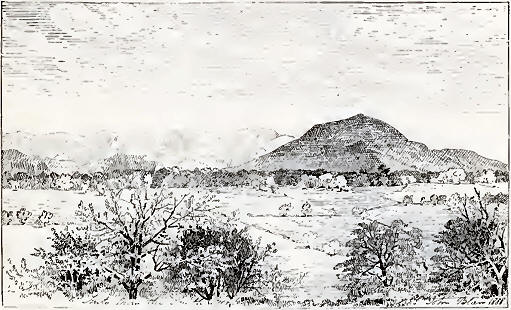|
Glasgow is well supplied with parks. The Green,
bordering the river above the bridge, has long been a favourite
place of recreation for the citizens and for assemblies of a civil
or military character. More than a hundred years ago Wilson gives us
a picture of a review on the “Green:”
“The Clydesdale heroes bright in arms are seen
To rival Rome’s in force and awful mien;
While, robed in red, fierce flame the lengthened lines,
From their bright arms a dreadful splendour shines;
While tubes that distant drive the death unseen,
Or gleaming swords flash terror o’er the Green.”
And since the first enrolment of a volunteer force in
1795, we have had many displays of the citizen-soldiers’ drill, and
the evolutions of the yeomanry, together with the military displays
of the “regulars.”
The Kelvingrove or West End Park was laid out by Sir
Joseph Paxton about 1854, and is beautified by walks and drives
along the slopes rising up to Park Terraco, from which extensive
views of the valley of the Clyde can be had. Indeed on a fairly
clear day the eye can range from Pen More in Glen Dochart to
Goatfell in Arran, whilst the Dunoon and Lock Eck hills bound the
western horizon.
From the Queen’s Park on the south side' of the river
a complete and comprehensive view of the Clyde valley can be had,
with Glasgow lying stretched around, curtained by a haze of smoke
from its innumerable chimneys, both domestic and manufacturing. When
the smoke nuisance is abated in Glasgow the visitor will then be
able to admire the regularity and handsomeness of its street
architecture. At present lie may study individual buildings, but no
fine vista opens out as it might do if the atmosphere were clearer
than it usually is in the busier part of the city.
From the Alexandra Park at the east end of the city
fine views of the Clyde valley as fail as Tinto can lie had, the
latter conical hill standing out distinctly thirty miles to the
east.

Tinto, near the source of the Clyde.
The districts of Govan and Partick have also now
their parks, showing the increase of population in the outskirts.
The parks are made' attractive to the citizens and
visitors by a varied and tasteful ornamentation of shrubs and
flowers, the latter arranged in a harmony of colour which delights
the eye; whilst in summer bands of music at intervals perform
selections from suitable stands around which crowd the old and
young, the grave and gay.
At the present time the lower part of the Kelvingrove
Park is being covered over with the buildings for the Glasgow
International Exhibition of 1888. The domes and pinnacles of the
temporary home of the industrial products of our nineteenth-century
civilization and mechanical skill rise above the long line of
buildings which are grouped almost at the feet of the University on
Gilmourhill, whose high tower with its now finished spire grandly
towers over all. This is a fitting association of the halls of
learning and the products of the workshop, the home of philosophy
with its cultured professors and eager students, and the courts of
the Exhibition filled with the products of the artificer, around
which circulates the stream of active life. Here we see once again,
after more than a century has passed away, that association of the
college and the workshop which led to such mighty consequences in
that far-back time when .James Watt in his little workshop within
the privileged walls of the old college in High Street, in repairing
the old Newcomen engine of the natural philosophy class, devised the
separate condenser, an invention to which so much of this grand
industrial collection is due. It seems, therefore, fitting, after so
many generations have passed away, during which even the old college
has left the grimy shades of the High Street and reared itself wider
and grander on the breezy slopes of Gilmourhill, that the industrial
products of the world should be spread around it, as if in
recognition of its early work in the field of philosophy and
science, and of such names as Simpson, Black, Adam Smith, and Watt. |

